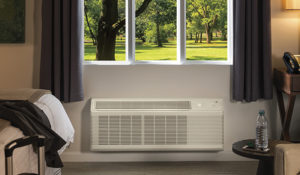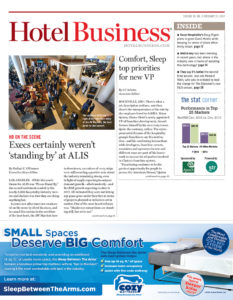
PTAC manufacturers are continuing to analyze sound quality, aiming to bring tranquility to the guestroom environment.
NATIONAL REPORT—PTAC manufacturers are honing their products by reducing noise, improving air quality and advancing technological features. Despite these efforts, some hotel chains are moving away from these eyesores and toward units offering architectural freedom. While this may be the case for some, others are still hanging onto these systems, mainly for the performance these units provide at the price point.
“In the old days, the number-one complaint for hotel guests when it came to the HVAC systems was sound of the PTAC,” said Barry Bookout, director of sales for lodging at Friedrich. “They were too noisy. They vibrated. They were very noisy when they started up and stopped. Sound is still paramount.”
In fact, according to Bookout, “Many of the manufacturers in today’s market have reduced sound levels to a very, very quiet level.” They’ve achieved this through sound-deadening technology, insulation technology, etc. Additionally, a lot of the motors and pressors being used today in products are “significantly better than the ones used even a decade ago,” he said.
“Noise is the top complaint people experience with PTACs,” said Brigitte Mader-Urschel, marketing manager of Zoneline and specialty air products at GE Appliances, a Haier Company. “Guests don’t sleep well if the AC is rattling throughout the night or they hear loud traffic noise. Loud units can cause low guest ratings, and with brand marketing tools such as the Hampton Guarantee, property owners may have to risk having to comp a room. Owners cannot afford to have noisy guestrooms.”
GE takes several factors into consideration when manufacturing PTAC units to achieve optimal quietness. For example, it analyzes sound quality—such as a smooth ramp-up, pitch and comforting sound. The most important point to consider: preventing outside noise from penetrating into the room. “This last point is especially important near roads and airports, since the design of a PTAC requires an opening in the exterior wall,” she said. “The level of noise insulation is demonstrated with a high sound transmission class (STC), and we see an increasing amount of architects spacing for STC.”
Rob Gallant, GM at Carrier Enterprise LLC, told Hotel Business that noise has always been a top complaint for guests at hotels. Carrier’s plan to overcome noise issues with PTAC units is to continue product development efforts in the upcoming year.
Quality control
Indoor air quality is not only growing into a notable aspect of PTAC functionality; it’s also a product characteristic gaining significance for HVACR manufacturers. According to a December 2016 AHR Expo and ASHRAE Journal survey of more than 1,400 HVACR manufacturers, a combined 89% of respondents indicated air quality being either “very important” (48%) or “somewhat important” (41%).
“Air quality is becoming increasingly important as flagships guarantee guest satisfaction. No one wants to lose revenue due to a loud or inefficient unit,” Gallant said.
Unfortunately, many hotel operators don’t clean their units, a concern for many manufacturers providing warranty service, said Bookout when speaking on common PTAC issues. “Maintenance and cleaning continues to be a big push for manufacturers, and it’s not typically done up to par in the hotel industry,” he explained, adding that cleaning a PTAC unit periodically is the number-one way to extend its life.
Technological advancements such as wall thermostats are becoming more sophisticated. These products have included energy management, occupancy sensing and remote management for heating/cooling for several years now; however, Bookout noted, “Every year, it seems like they become more and more of a focus.”
His thoughts align closely to the 15% of open-ended responses from the aforementioned survey. Across the HVAC industry, survey answers addressed the issue of connectivity, improved equipment integration and technology platform protocols, and the increasing role played by the Internet of Things (IoT). Diving deeper, this percentage of respondents noted the importance of advancing smart controls and capabilities.
Improving efficiency with PTAC units through new technology is also a major focus for some manufacturers. “New technologies, such as inverter designs, are also some options in the future to increase efficiency,” Mader-Urschel said, noting a relationship between efficiency and a property’s profitability. “However, these designs also require higher upfront cost and need to be carefully evaluated for payback.”
The future of PTACs may not be decided by the manufacturers themselves but rather the hotel chains they’re selling product to. “In general, year after year, more hotel chains are designing their hotel rooms around the closet-mounted vertical unit rather than PTACs,” Bookout said, noting that both Marriott and Hilton, two of Friedrich’s largest hospitality clients, have had conversations with him about this shift in approach.
Instead of seeing a PTAC unit, the only interaction with a vertical unit is a wall-mounted thermostat. “There’s a stigma around PTACs that you’re staying at a certain level hotel when you walk in and immediately see a big piece of equipment sticking out of a wall. What a vertical unit gives you is a homelike feel,” he said.
That being said, PTACs are here to stay for certain clients. “They’ve been a great, cost-effective solution for decades, and they’re not going anywhere in the long-term,” Bookout said, adding that they’ve become more efficient and quieter, and their technology has been improving. “For a huge number of hotel chains, properties, owner groups and management companies, PTAC is still the go-to product because, like I said, it does give you so much performance with a low price tag, and they’re really easy to swap out.”
“The industry is growing largely due to an increase in hotel construction,” Mader-Urschel said. “PTACs are commonly used in many chainscales and broad construction growth across scales drives an increase in PTAC shipments. Overall, PTACs are a staple of the industry. A high-quality unit that lasts will provide long-term benefits to owners—through high guest ratings, reliable uptime and low electricity costs.” HB

